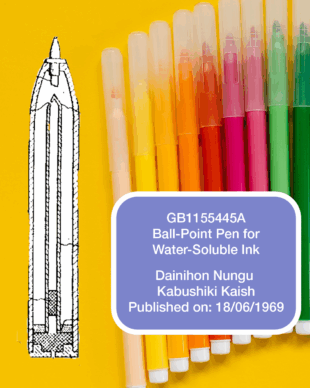Did you know that the pen sitting on your desk contains centuries of intellectual property (IP) and innovation? While jotting down notes or signing documents, you're wielding a product of remarkable technological evolution. In today’s blog we’re exploring the fascinating history of how writing instruments have progressed through the ages, and the IP that made it possible.
Long before digital technology, our writing journey began with a Sumerian stylus pressing wedge-shaped characters into clay tablets. Writing instruments evolved through reed pens and quills, with the latter dominating European writing for more than a millennium before the metal pen revolution transformed how we communicate.

The steel revolution
The 1800s marked a significant turning point with the emergence of the steel point pen, with Britain playing a crucial role in this development. Bryan Donkin secured the first patent for a steel pen with an ink reservoir in 1808, although he later auctioned the rights to focus on his paper-making ventures.
Mass production made steel pens more durable and consistent, while greatly reducing costs. This supported rising literacy rates and enabled the expansion of education, business documentation, and government record-keeping during industrialisation – an example of how protected innovation can impact society, perhaps?
The fountain pen (a pen with a reservoir that feeds ink continuously to the nib) emerged in the early 19th century, addressing the need for reliable portable writing. While Romanian inventor Petrache Poenaru secured the first patents in 1827, Lewis E. Waterman's development of the three-fissure feed system solved critical leakage problems that had limited earlier designs. The Waterman Pen Company continues to operate today, testament to the enduring value of this protected innovation.
A flying start for the ballpoint
The ballpoint pen story begins with American John J. Loud's 1888 patent, though his design faced challenges with ink flow and paper performance. The true breakthrough came from Hungarian brothers László and György Bíró, whose metal ball tip delivered ink with remarkable consistency.
Recognising its potential, the British government licensed the patent rights from Bíró for use during World War II (US2258841), with the Miles Martin Pen Company producing "Biro" pens for RAF pilots that functioned reliably at high altitudes. When British firm J. Parker licensed Bíró's patents in 1951, they helped establish the commercial foundation for truly affordable, reliable pens that functioned across diverse environments and surfaces.

Colour innovation
The felt-tip pen arrived in 1962 when Tokyo Stationery Company's Yukio Horie patented a pen (GB1155445A) with a porous felt point saturated with ink. Unlike their predecessors, these pens offered unique controllability for various line widths, making them versatile for both writing and artistic applications.
The development of water-based inks in the late 1960s and early 1970s made felt-tip pens more practical for everyday use. They became less likely to bleed through paper and introduced vibrant colours to everyday writing, expanding the limited palette of traditional ink pens.

Digital transformation
Today's digital pens represent the sophisticated integration of traditional writing and modern technology. These devices have evolved dramatically from early designs that used special paper with invisible dot patterns.
Key innovations include pressure sensitivity technology that captures writing dynamics, internal memory allowing thousands of pages to be stored within the pen itself, and wireless capabilities enabling real-time transmission to connected devices. Advanced handwriting recognition algorithms now convert written notes into searchable, editable text with impressive accuracy.
Modern iterations like Apple Pencil and Samsung's S Pen demonstrate seamless integration with digital ecosystems. Recent developments include surface independence through motion sensors and synchronised audio recording that links notes to spoken content, protected by patents such as US9329703B2.
Protecting Pens
Throughout this journey from steel nibs to digital styluses, intellectual property protection has been fundamental to pen innovation. Each patent built upon previous work while introducing novel improvements, creating a continuous cycle of innovation spanning centuries.
The pen's evolution demonstrates how IP protection drives technological progress - rewarding innovation while creating a documented knowledge base for future inventors. Today's digital writing tools exist because generations of inventors could secure their intellectual contributions. The humble pen is not just an instrument for writing, but a compelling example of how IP protection enhances human creativity and communication.
Innovation continues
Next time you use a pen, consider the remarkable journey of protected innovations it represents. From quills to touchscreens, the story of how we write reflects our ongoing pursuit of better tools for thinking, creating, and communicating – all supported by intellectual property protections that continue to encourage new developments.
Whether your preference is for fountain pens, ballpoints, or digital styluses, the story of writing instruments offers a fascinating glimpse into how intellectual property has shaped and improved the tools we use every day.
Keeping pen pals
If this exploration of the pen's intellectual property journey has captured your interest, why not write yourself into our regular audience? Subscribe to our IPO blog for a steady stream of fascinating IP stories that will help you draw connections between innovation and protection. With new posts delivered straight to your inbox, you'll never be left scratching your head about intellectual property matters.
1 comment
Comment by Clive Bonny posted on
Did someone once say "the power of the pen is greater than the sword"?